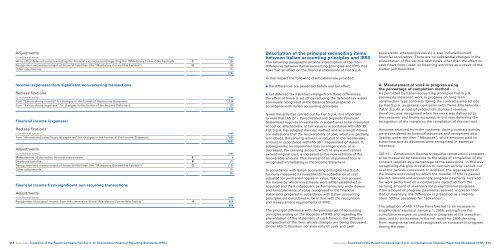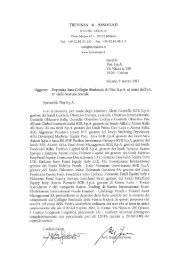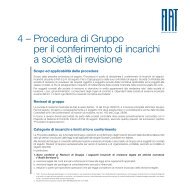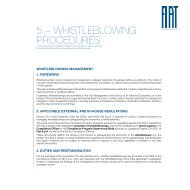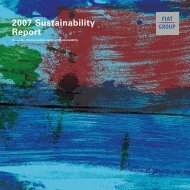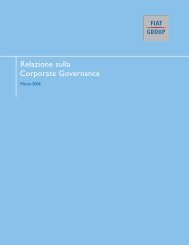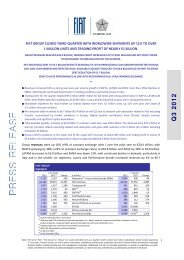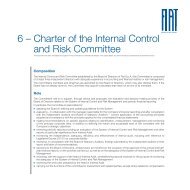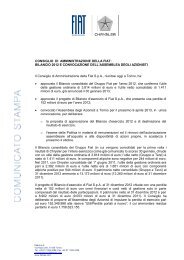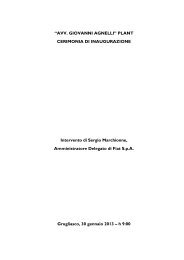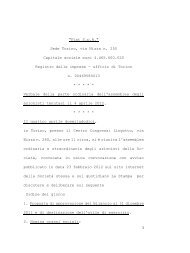2006 Annual Report - Fiat SpA
2006 Annual Report - Fiat SpA
2006 Annual Report - Fiat SpA
Create successful ePaper yourself
Turn your PDF publications into a flip-book with our unique Google optimized e-Paper software.
Adjustments<br />
(in millions of euros) 2005<br />
Write-off of deferred costs (excluding the financial expenses costs regarding the “Mandatory Convertible Facility”) C (15)<br />
Recognition and measurement of financial liabilities (the “Mandatory Convertible Facility”) G (8)<br />
Other adjustments (1)<br />
(24)<br />
Income (expenses) from significant non-recurring transactions<br />
Reclassifications<br />
(in millions of euros) 2005<br />
from “Extraordinary income” for changes in the format of the Income Statement 1,135<br />
from “Extraordinary expenses” for changes in the format of the Income Statement (2)<br />
1,133<br />
Financial income (expenses)<br />
Reclassifications<br />
(in millions of euros) 2005<br />
from “Interest and other financial expenses” for changes in the format of the Income Statement (169)<br />
(169)<br />
Adjustments<br />
(in millions of euros) 2005<br />
Measurement of derivative financial instruments E 8<br />
Employee benefits B (1)<br />
Recognition and measurement of financial liabilities (the “Mandatory Convertible Facility”) G (13)<br />
Other adjustments (1)<br />
(7)<br />
Financial income from significant non-recurring transactions<br />
Adjustments<br />
(in millions of euros) 2005<br />
Recognition of unusual income from the conversion of the “Mandatory Convertible Facility” H 858<br />
858<br />
312 Appendix Transition of the Parent Company <strong>Fiat</strong> S.p.A. to International Financial <strong>Report</strong>ing Standards (IFRS)<br />
Description of the principal reconciling items<br />
between Italian accounting principles and IFRS<br />
The following paragraphs provide a description of the main<br />
differences between Italian accounting principles and IFRS that<br />
have had an effect on the financial statements of <strong>Fiat</strong> S.p.A.<br />
In this respect the following clarifications are provided:<br />
■ the differences are presented before any tax effect;<br />
■ net deferred tax liabilities emerge from these differences;<br />
the effect of these is set off by reducing the deferred tax assets<br />
previously recognised in the Balance Sheet prepared in<br />
accordance with Italian accounting principles.<br />
Given the activities carried out by <strong>Fiat</strong> S.p.A. it is important<br />
to note that IAS 27 – Consolidated and Separate Financial<br />
Statements requires investments in subsidiaries to be measured<br />
at cost or, alternatively, at fair value in accordance with IAS 39.<br />
<strong>Fiat</strong> S.p.A. has adopted the cost method and as a result if there<br />
are indications that the recoverability of cost, wholly or partially,<br />
is in doubt, the carrying amount is reduced to the recoverable<br />
amount in accordance with IAS 36 – Impairment of Assets. If,<br />
subsequently, an impairment loss no longer exists or is<br />
decreased, the carrying amount, which in any event cannot<br />
exceed original cost, is increased to the new estimate of the<br />
recoverable amount. This reversal of an impairment loss is<br />
recognised immediately in the Income Statement.<br />
In accordance with Italian accounting principles <strong>Fiat</strong> S.p.A.<br />
formerly measured its investments in subsidiaries at cost<br />
adjusted for permanent losses in value. Taking into account<br />
the means by which investments were either established or<br />
acquired and their subsequent performance, any write-downs<br />
and reinstatements of value recognised in the financial<br />
statements prepared in accordance with Italian accounting<br />
principles are considered to be in line with the recognition<br />
and measurement requirements of IFRS.<br />
The principal difference with the previous set of accounting<br />
principles arising on the adoption of IFRS and regarding the<br />
presentation of the statement of cash flows is the different<br />
composition of the item whose changes are being discussed.<br />
Under IAS 7, this item consists only of cash and cash<br />
equivalents, whereas previously it also included current<br />
financial receivables. There are no substantial changes in the<br />
presentation of the various cash flows other than the effect on<br />
cash flows from (used in) financing activities as a result of the<br />
matter just described.<br />
A. Measurement of work in progress using<br />
the percentage of completion method<br />
As permitted by Italian accounting principles <strong>Fiat</strong> S.p.A.<br />
previously measured work in progress on long-term<br />
construction-type contracts (being the contracts entered into<br />
by <strong>Fiat</strong> S.p.A. as general contractor with Treno Alta Velocità –<br />
T.A.V. S.p.A.) at cost of production. Contract revenue,<br />
therefore, was recognised when the work was delivered to<br />
the customer and finally accepted, in this way deferring the<br />
recognition of the margin to the completion of the contract.<br />
Amounts received from the customer during contract activity<br />
were considered as financial advances and recognised as a<br />
liability under the item “Advances”, while amounts paid to<br />
subcontractors as advances were recognised in assets as<br />
inventory.<br />
IAS 11 – Construction Contracts requires construction contracts<br />
to be measured by reference to the stage of completion of the<br />
contract, applied as a percentage to the sales price, in this way<br />
recognising margins in relation to contract activity carried out<br />
over the periods concerned. In addition, the legal aspects of<br />
the means and timing by which the transfer of title is passed<br />
are not relevant and accordingly progress payments received<br />
for work performed on a contract are deducted from the<br />
carrying amount of inventory for presentational purposes.<br />
If the amount of progress payments received is greater than<br />
that of inventory, the difference is presented as a liability<br />
(item “Other payables) for “advances”.<br />
The adoption of IAS 11 has therefore led to an increase in<br />
stockholders’ equity at January 1, 2005, arising from the<br />
cumulative margins on contracts in progress at the transition<br />
date, and to an increase in the net result for 2005 deriving<br />
from margins earned and recognised on contracts in progress<br />
during the year.<br />
Appendix Transition of the Parent Company <strong>Fiat</strong> S.p.A. to International Financial <strong>Report</strong>ing Standards (IFRS) 313


